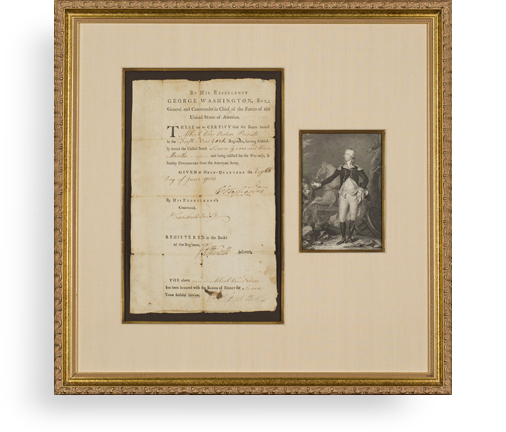President Abraham Lincoln, After Enactment of the First Conscription Act in American History, Issues a Draft Call in September 1863


It was issued in the wake of the Battle of Gettysburg, in which the Union sustained severe losses
- Currency:
- USD
- GBP
- JPY
- EUR
- CNY
“I, Abraham Lincoln, President of the United States of America, and Commander-in-chief of the Army and Navy…order that a draft be made”
This document comes from the collection of “Patton” actor George C. Scott
After the firing on Fort Sumter on April 12, 1861, enthusiasm for enlisting in military service swept...
“I, Abraham Lincoln, President of the United States of America, and Commander-in-chief of the Army and Navy…order that a draft be made”
This document comes from the collection of “Patton” actor George C. Scott
After the firing on Fort Sumter on April 12, 1861, enthusiasm for enlisting in military service swept through both the North and South. In remarkable speed two large volunteer armies were created. Except for a tiny number of professional soldiers, all expected to be in service for a brief term. Not just soldiers but the public and political leaders had fooled themselves about the war’s likely duration. However, the patriotic hope on each side that the war would be over in a matter of weeks or months was dashed in the first battle of Bull Run on July 21, 1861. By late 1862, no sensible person believed that an early end to the bloody strife was possible, and the knowledgeable expected peace to be far off in the future. Facing a protracted war, maintaining a sufficiently sizable army became the greatest problem facing both Union leader Abraham Lincoln and Confederate leader Jefferson Davis.
In 1862, rather than institute a draft, President Lincoln requested 300,000 more men and assigned each state a quota. The states could meet their quota in any manner they saw fit. Most states offered cash incentives, known as bounties, to gain recruits. Depending on where one enlisted, the combination of local, state, and federal bounties could exceed $1,000. But the 1862 policy also did not recruit enough troops.
As the war dragged on with no end in sight, the inflow of volunteers was drying up, and the Union needed to keep the ranks filled. The Emancipation Proclamation went into effect January, 1, 1863, which dampened enlistment. The U.S. Congress resorted to the first draft in the country’s history in March 1863. All able-bodied men between ages 20 and 45 were required to be enrolled and available for military service. Draftees were chosen by lottery. Once conscripted, a man could avoid service for that particular round of the draft either by paying a $300 commutation fee or by hiring a substitute to take his place. As in the South, this raised accusations that the war had become “a rich man’s war but a poor man’s fight.” Nevertheless, in both North and South, statistics indicate that wealthy men were represented in the service in at least the same proportion as they were in the general population. Nonetheless the draft call led to riots, including in Ohio.
Early July saw the bloody Battle of Gettysburg, which thinned the Union ranks.
Document signed, Printed Executive Mansion letterhead, Washington, September 5, 1863: “I, Abraham Lincoln, President of the United States of America, and Commander-in-chief of the Army and Navy thereof, having taken into consideration the number of volunteers and militia furnished by and from the several States, including the State of Ohio, and the period of service of said volunteers and militia since the commencements of the present rebellion, in order to equalize the numbers among the Districts of the said States, and having considered and allowed for the number already furnished as aforesaid, and the time of their service aforesaid, do hereby assign six hundred and sixty two as the first proportional part of the quota of troops to be furnished by the 19th District of the State of Ohio under this, the first call made by me on the State of Ohio, under the act approved March 3, 1863, entitled “An Act for Enrolling and Calling out the National Forces, and for other purposes,” and, in pursuance of the act aforesaid, I order that a draft be made in the said 19th District of the State of Ohio for the number of men herein assigned to said District, and Fifty Percent in addition…”

Frame, Display, Preserve
Each frame is custom constructed, using only proper museum archival materials. This includes:The finest frames, tailored to match the document you have chosen. These can period style, antiqued, gilded, wood, etc. Fabric mats, including silk and satin, as well as museum mat board with hand painted bevels. Attachment of the document to the matting to ensure its protection. This "hinging" is done according to archival standards. Protective "glass," or Tru Vue Optium Acrylic glazing, which is shatter resistant, 99% UV protective, and anti-reflective. You benefit from our decades of experience in designing and creating beautiful, compelling, and protective framed historical documents.
Learn more about our Framing Services










































































































